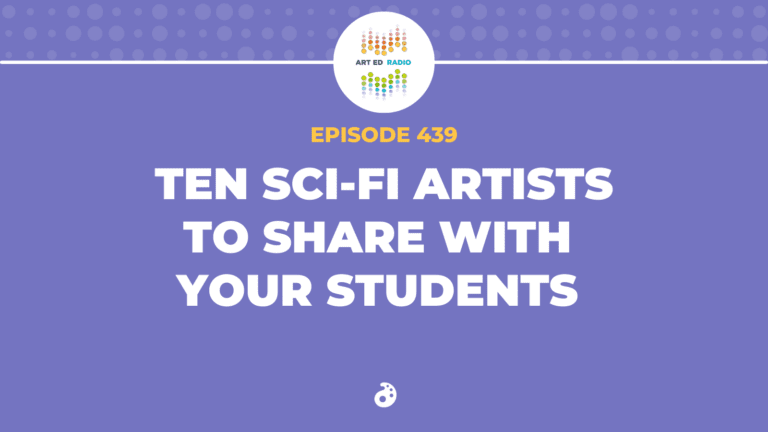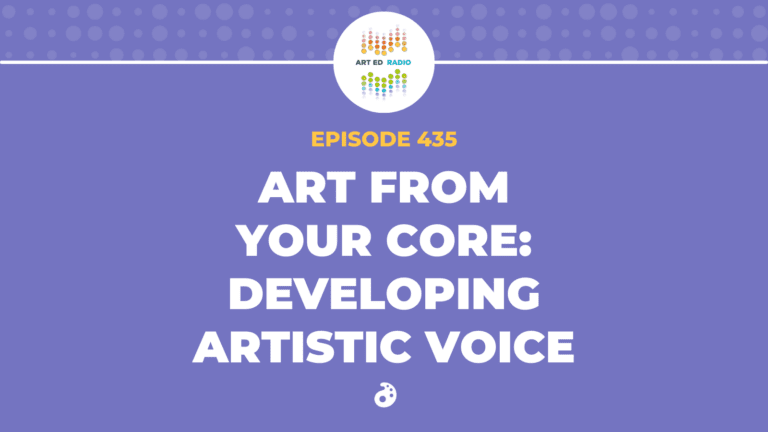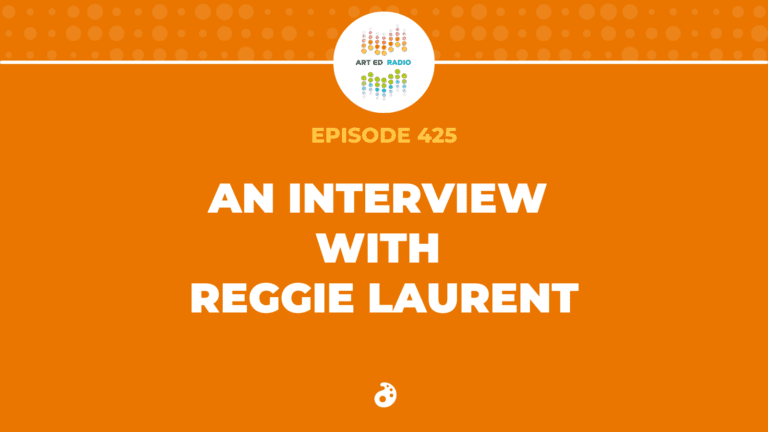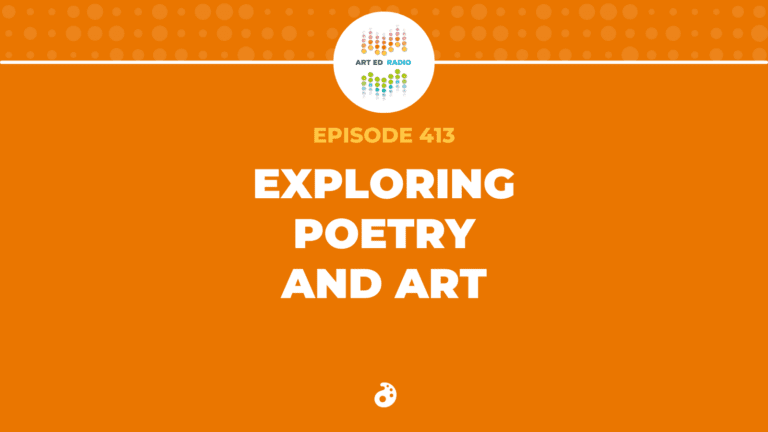Jonathan Juravich returns to the show to talk more about how we teach awareness and empathy in the art room. Since his last appearance, Jonathan has given a TED talk and continued to spread the word about the importance of social and emotional learning. Listen as he and Tim discuss what it’s like to give a TED talk, how we make the art room a safe space for our kids, and why we need to have purposeful conversations with our kids. Full episode transcript below.
Resources and Links
- You can watch Jonathan’s TED Talk here
- You can take a quick look at Jonathan in his classroom here
- Follow Jonathan on Twitter
- A great write-up on Jonathan and his arts advocacy work
- Take a look at the Masterclass Jonathan is developing on Creative Strategies for Social and Emotional Learning
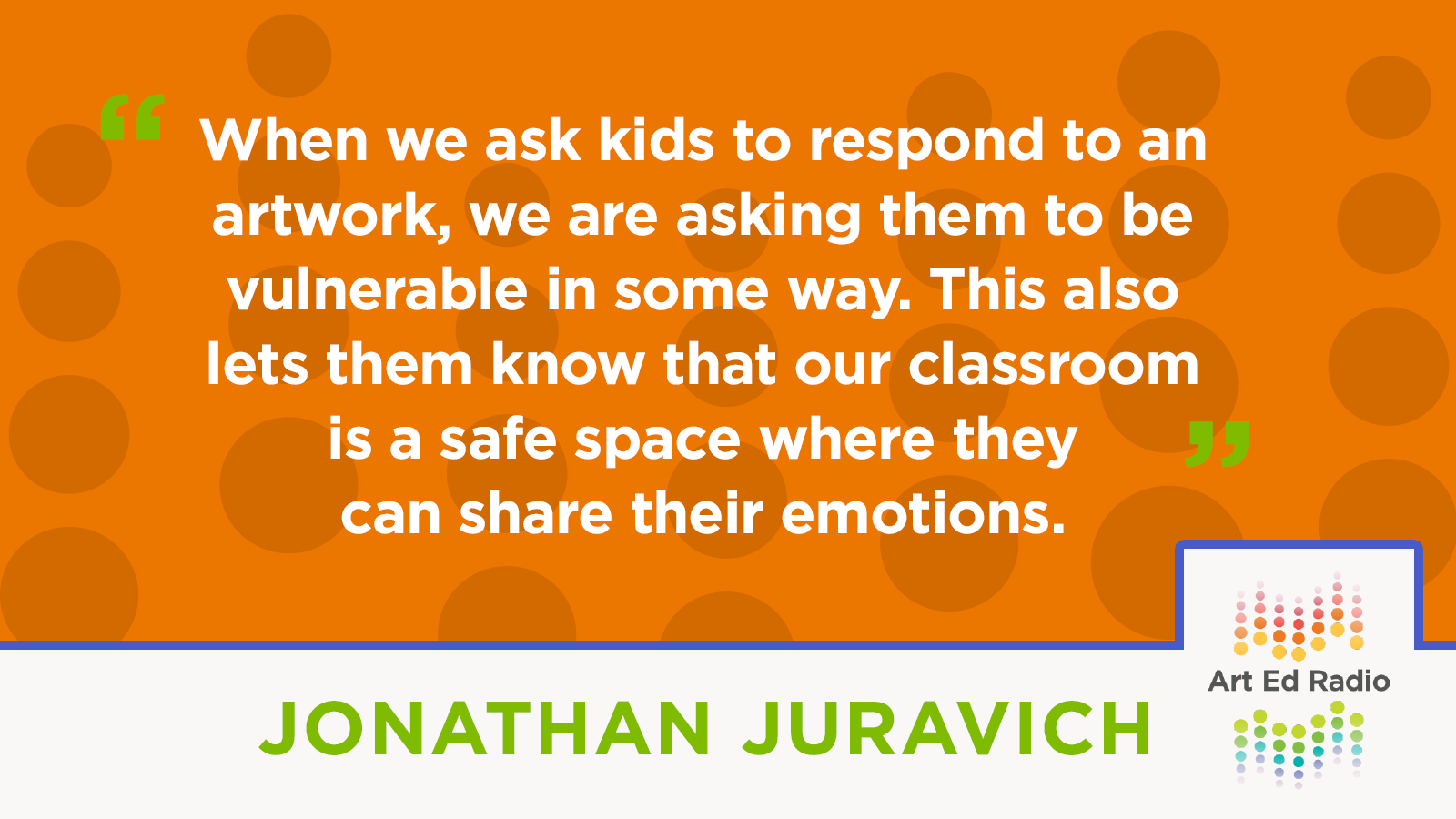
Transcript
Tim: Welcome to Art Ed Radio, the podcast for art teachers. This show is produced by the Art of Education University, and I’m your host, Tim Bogatz.
Jonathan Juravich will be my guest today. He was the teacher of the year for Ohio in 2018 and one of the finalists for the National Teacher of the Year Award. He’s been on the podcast before. You’ve seen him at the Art Ed Now conference as well. You probably remember him, but since the last time he’s been on, something super exciting, he actually recorded a TED Talk. And you know, one of Jonathan’s passions is teaching kids how art can make a better world and fostering empathy through the lessons he presents and how he teaches his kids, and this is something that he does really well, and it was the main focus of his TED Talk. How do we teach empathy? He has some great ideas about how empathy isn’t just a soft skill, like there are actionable ways that we can help our students become more empathetic. So let me go ahead and bring him on, and hopefully he can share some of those ideas with us today.
All right. And joining me now is Jonathan Juravich. Jonathan, how are you today?
Jonathan: I am doing fantastic.
Tim: Good.
Jonathan: Really.
Tim: Well, I am very excited to talk to you. It’s been a while since you’ve been on an episode, and in the meantime, when you haven’t been on, you’ve been busy giving TED Talks. So I have lots of questions of how to TED Talk, so I’m going to throw a bunch of them at you, and we’ll see what you want to answer.
So first of all, I really want to know what it’s like to give a TED Talk, if you can share that experience, and also like, do they just call you one day and say, “Hey, we want you to do a TED Talk”? And then like once you have figured out that you’re going to do this, like what is it like to plan and prepare for that, put it all together, and like what is the experience of doing a TED Talk?
Jonathan: Wow. Okay. So great questions. I mean, like how long do we have, right? This has been a wild experience, to say the least, and it all started back in, oh, my goodness, I guess January or early February of 2018. I was named the 2018 Ohio teacher of the year, and all the teachers of the year got together out at Google, Google’s headquarters. While we were there, there were two representatives from TED-Ed, from the education branch of TED, and they told us, “You’re going to be involved in this top secret project.” And of course-
Tim: Sounds exciting.
Jonathan: Yeah. And I’m like, “What?” Anything TED says, let alone something top secret. So what we learned is that they were going to take all of us and we were allowed to choose a partner from outside of our cohort of teachers, and we were going to be led through these modules that basically got us to investigate, if we wanted to give a TED style talk, what would we talk about? What would the structures of that talk look like?
And so I selected an art teacher that I know here in Ohio, and the two of us worked through these modules together, and throughout the whole thing I was behind, hitting all the deadlines, and even whenever we had a chance to actually meet up with the people from TED again, from TED-Ed and check in, I said, “Well, I really don’t have much but here’s kind of my idea of what I want to talk about,” and then it came down to the deadline of when you had to send them basically filming in your living room like you giving a TED Talk to basically your family. Yeah, it was like an audition tape when we were at the end. And throughout all of this, it’s been very much like a secret. Right?
Then at the end I submitted my proposal like audition tape of my TED Talk and sent it to them and thought, “Well, that was a great experience,” and I and my partner basically submitted to different conferences saying like, well, because we’re never going to get a chance to actually give our TED Talk, like what if we did it at our state association conference and, you know, like all these other things. And then I got an email in the summer saying, “Hey, we really enjoyed your video and we want you to do this for real.” So, yeah.
The whole premise of this project was that TED really wants to make it available that so many more educators are sharing their stories and their ideas, and so we were kind of like their Guinea pigs to go through this experience and through these different modules that they’re going to be opening up to many more teachers to be a part of this experience.
So, yeah. So then TED themselves … Actually, her name is Steph, but …
Tim: Not actually Ted.
Jonathan: No, not actually Ted. So yeah, so Steph from TED-Ed worked with, there were three teachers of the year that were selected to come give their talks, and she worked with us closely going over our scripts, going over our PowerPoint slides that were going to be shown throughout it, and really talking about really kind of making it concise and purposeful and memorizing, which memorizing is not a skill I have, and so here’s your pro tip, right? So what I did is I actually recorded myself on my phone, and every time I got in the car, driving to school, driving to pick up my kids from daycare, I would listen to me give my talk, and I’d say it along with my recorded self. Right? So it was kind of like two Jon Juraviches at once.
Yeah. And then in last fall is when they brought us all to New York city and went to TED’s headquarters and got to stand on the red dot at TED to give my talk, which was an experience unto itself. Right? So …
Tim: Yeah, for sure.
Jonathan: Yeah. And it was wild because being there on a Sunday morning and seeing how many people, staff people from TED were there to make this happen. I mean, even from the makeup artists that are saying, “Oh, you’re pretty shiny,” or, “Do you sweat much?” Yes, it’s one of my gifts, so let’s be prepared for that. And you know, it was an incredible experience. And then in the audience were people from my cohort of teachers here, as well as people from New York City’s Department of Education were there because the chancellor of New York City schools was also giving a talk that day. Yeah, not overwhelming at all.
So, yeah. I mean, it was an incredible experience that I think back on all the time and consider myself so fortunate to have had that opportunity and to share something that I’m so passionate about.
Tim: Yeah, that’s really cool. And you know, I actually … Well, first, I’ll just say we’ll link to the TED Talk so everybody can find that, everybody can watch that, but I want to drill down a little bit into some of the things you talked about there, because for me one of the big takeaways was that, when you said that we do what we do as art teachers and it’s a type of teaching that goes beyond artists and beyond cultures and beyond art materials, that our teaching should be about empathy and understanding. I know these are things you’re really passionate about, so can you kind of expand on your reasoning and your thinking there about why we need to do so much with empathy and with understanding?
Jonathan: Yeah. I think that we have a really unique opportunity as art teachers because we have these spaces where kids are working next to each other or with each other all the time, and they have to learn almost innately how to … I mean, it’s not like we spend time saying like, “Here’s the bin of scissors. Everybody has to share.” I mean, we do, but there’s all of these shared spaces and supplies, and it’s very a natural part of our work in the art room is about understanding and working alongside one another. But our world is so big and so vast, and we have this opportunity, again, as art teachers, to talk about cultures from other sides of the world and trying to get to understand who they are, why they create the work that they do, how we can connect with those people, and that they are people, and I think that’s really powerful for us to talk to our students about the fact that there are kids just like you, fourth grader, there are kids just like you on the other side of the world.
But my talk, the whole premise of my talk is this idea that empathy is this word that we kind of like throw around like some of the art teachers listening to this throw around glitter, right? It’s just like everywhere. Like we say empathy, almost to the point where it doesn’t even feel like it means a whole lot anymore because it’s such a … It’s a powerful word, but it’s a word that’s used so much. And so I say that before we can have these actions of empathy, we almost have to take a step back and build into this idea of building awareness, and because if we’re able to build an awareness of others, an awareness of how we’re feeling internally, an awareness of our surroundings, then we can begin to have these actions of empathy that come from them. But it’s having the conversations about awareness building first that are going to get us anywhere.
Tim: And, like as art teachers, do you think we can do that best? And, how do I want to put this? Like if we are the ones that can do it best, do you think it’s our responsibility as art teachers to try and discuss and foster awareness and teach our kids empathy?
Jonathan: I mean, I think it’s an opportunity for all teachers, and no matter what your content area, right? But I do think that the important work of social and emotional learning, it’s upon us, right? Getting kids to understand about the decisions they make, the impact that they have, and these are conversations that we as art teachers need to be a part of. We need to, and to make sure that we’re a part of them within our schools. I think one of the things that’s really important that we do is that we as art teachers, especially many elementary art teachers, see every kid in the building. I mean, I see my students from kindergarten through fifth grade, and then I work with them as a coach in middle school. I mean, I am very much a part of their lives year after year, and I get to see them grow and develop as this amazing little human being.
And so knowing that I have that type of impact on them and that history with them, I think it’s incredibly important that I’m teaching them about being a human, right? Like being human. It’s so much of what we touch on with our study of artists and art appreciation and cultures, but I mean, if we can be really direct with it, we can really have a powerful impact on their lives. That’s why I’m really excited about … I mean, normally I can’t stand buzz phrases. They just kind of like, they eat at me. Right? It’s like I kind of turn into that grumpy troll under the bridge that’s like, “No, I don’t want anything to do with that.” But like this work of social and emotional learning at least brings us all into the conversation with common vocabulary and common language so that the art teacher, the science teacher, the intervention specialists, we can all be a part of this work for our kids.
Tim: Yeah, that’s a really, really good thing and a good way to approach it. I also kind of wanted to circle back though on something that you said before about the art room kind of being this place where inherently kids are working together, working next to each other. It’s kind of a safe place for them to explore feelings, I guess, and just kind of how they can interact with other people. So do you think that sort of exploration should be through conversations with the people they’re sitting with, conversations with us as teachers, through the art that they’re making in our room? Or is it maybe an all-of-the-above sort of approach?
Jonathan: I would like to select all of the above as my answer and leave it there. No. No. That would make for a great discussion. Right? All of them. I think that what’s really important … I mean, I’m coming from the lens of an elementary art teacher, right? And in first grade I have these discussions with my students about the fact that I love creating self-portraits with my students, and I do every year from kindergarten all the way through fifth grade, at least one a year. I think it’s a really important way for them to see their development, to study different approaches, but then in first grade we talk a lot about the fact that our kids often just make these happy, smiley self-portraits, right? Because it’s what their audience wants. It’s what their parents want to hang up, right? Is these happy, smiling portraits.
But we talk a lot about the fact that we’re not always happy and smiley, and I talk through with the kids and we look at examples of famous works of art where that’s not always true, and we brainstorm every single feeling that they can come up with. Normally, it’s just like happy, sad, grumpy, sleepy, right? And then there’s of course, Bennett, the first grader who says flabbergasted, but by brainstorming all those emotions, then we have these conversations about like, well, what does that actually look like? And whether we realize it or not, our kids are constantly studying us. They’re aware of the way we react to things as teachers, as parents, as their peers, and they know. They know what it looks like when someone’s upset. They know what it looks like when someone’s angry, and they are beginning to be able to show those emotions through their artwork as well.
So that’s kind of like one of those where they’re having a conversation with me as a teacher, they’re having it with their peers, they’re also doing it in their art making, and I think those, again, those are really powerful moments. That’s just one small example of talking about their feelings, but I think that when we ask them to respond to works of artwork, whether it’s written or in front of a classroom, and we ask them their opinions on things, we’re already asking them to take a leap, to share, to share their … and be vulnerable, to share their experiences and what they’re seeing on the screen or an image that we’re showing. And so it’s very natural then for them to kind of see our spaces as a safe place to share their feelings and their intuitions.
Tim: Yeah, that’s a really good point. I kind of want to ask a little bit more about that too. You know, obviously in doing self-portraits, talking about that, lends itself to opening up a little bit, but you know, what are some other ways that you have those purposeful conversations with your kids in your classroom? Like how do you approach that? How do you encourage kids to talk a little bit more about how they’re feeling, and also I guess awareness about how other people are feeling as well? Like what examples can you give for people who are listening or suggestions you have to kind of let them get started with those conversations in their classroom?
Jonathan: Yeah. Well, I love using books as a starting point, and I have two kids as well at home. I have a six year old and a two year old, and a lot of the books that I share at school, I also bring home, and vice versa because I feel like sometimes when I’m at a loss of how to start a conversation that needs to happen or can be really purposeful and intentional and I’m like, “Ugh, how do I even begin this?” It’s like, well, let’s go to a picture book and begin with reading it, discussing the expressions on the faces of the characters within the picture books.
I have two right now that I’m a huge fan of. One of them is called Spoon, and it’s this book about a little spoon who is very aware of how all of his other cutlery friends do these really special things, right? Like the fork does this, and the chopsticks are so glamorous, and they’ve always got a buddy. And at the end, the spoon begins to have this self-awareness about how incredibly special it is and the cool things that it gets to do as a spoon. And of course, we’re talking about like, again, silverware in a silverware drawer, but it’s a really amazing jumping off point for us to not only have conversations about how, in the art room, sometimes we’re really skilled innately in one certain technique or one certain material, and maybe not so much in another one. And so having those conversations with kids about how that’s something we work at, that’s something we can appreciate in other people, and again, starting with a book maybe about a spoon is kind of a way to begin having those conversations.
There’s two other books that I’m … And here I am on this book route right now, but like I think that, again, it’s a one simple way that we could start these conversations, but one of them that I’ve picked up recently is called Perfectly Norman, and it’s this book about this little guy who one day sprouts these beautiful wings, and they’re beautiful, bright colored feathers, and he doesn’t want anyone to know about them, so he covers it up and he’s covering up like who he is, his identity. Then throughout the book he realizes like, “Wait, I should share who I am, who I am.” And you know, he’s got these beautiful, amazing wings. I think back to all of the different images that I see from teachers where they’re creating these interactive sets of wings in their classrooms or in their schools where each of the kids create a feather and attach it onto these giant wings. This would be a really intentional way to talk about like your own self and being aware of yourself.
We did this at our school before using that idea, and each kid created a feather that was a symbolic representation of themselves. So it either included their favorite colors or their favorite sports teams or imagery or symbols that represented themselves just on one single feather, and then by adding it onto a giant set of wings, it talked about our collective school and who we are.
Tim: Yeah. That’s a great idea.
Jonathan: I mean, it’s something so simple that starts with reading a book and made it more intentional. I’ve seen so many of those wings projects, but again, and they look amazing, but if we maybe just added in this conversation that was really purposeful, it could take it down a totally different route.
Tim: Yeah, absolutely.
Jonathan: Yeah. And I even think back, I think to our impact on one another and this awareness idea. I, with my kindergartners, I love showing kindergartners abstract works of art because I think for most cases they think that a lot of artwork has to look like a flower or a tree or a puppy.
Tim: Yeah. Yeah.
Jonathan: Right? So, I show them work of like abstract expressionists. We make a giant mural together like Jackson Pollock style, and at first they’re all sitting on the floor painting on it, and then I hand them ketchup bottles full of paint, and like that could be a moment for it really to go awry. Right? Handing a five-year-old or six-year-old a ketchup bottle of paint, but we have conversations about like, okay, let’s talk through all the different ways we can hold this bottle, and how if I hold it out this way, I’m going to squirt my friend. If I hold it over here, I get my new shoes, but if I hold it over here on the paper and move it back and forth, that’s getting actually what we want out of this, that’s meeting our goals.
And again, it’s something we’re already doing. Like we already are having those conversations with kids. It’s almost saying like, “Wow, we’re doing a great job of this.” So celebrating those conversations we’re having and then, again, making them really intentional.
Tim: Yeah, that’s really cool. All right, now we’re just about out of time, but I do have one last question that I want to ask you. Just kind of how we can make sure kids are going out into the world with these ideas, and let’s just … You know, how do we make these lessons of respect and empathy, how do we make them sticky? How do we make them stay with our students? Like, how can we as art teachers ensure that they are learning those lessons that we’re trying to teach them?
Jonathan: Yeah. Well, at our school we did this thing a couple of years ago where we developed, I guess it’s like a character education program or plan where we have our … I teach at Liberty Tree, so everything’s a tree or a leaf or like a woodland creature, but they’re called our tree traits, and respect, empathy, awareness and perseverance are those words, and what we did is we explicitly said to the kids what respect looks like, what awareness looks like, what perseverance looks like, so that the kids actually knew like, hey, this is what respect looks like in the art room, or this is what respect looks like in the cafeteria, or what empathy looks like at the playground. So instead of just saying, “Be empathetic, be respectful, or walk in someone else’s shoes.” Instead of saying things like that, that seem so abstract, it’s actually tying observable actions to them so that they can actually see and understand what they are and then be able to apply those to their life.
The other thing is this common language, like instead of being like super cute about it, like actually using the word respect, empathy. I had a music teacher in my building who one day came running down the hallway to me and she like gave me a high five and I said, “What? What’s going on?” And she goes, “Well, we did it.” I was like, “What did we do?” Right? Like I’m getting excited even though I have no idea what we’re excited about. She said, “Well, I had a fourth grader that was playing a recorder and really was having a hard time with it,” and oh, man, recorder.
Tim: Yeah.
Jonathan: Right, yeah. And was really challenged with it and having a hard time, and then another fourth grader, like when he finally got it, when he finally got the piece of music, another fourth grader turned to him and said, “You really showed perseverance when you didn’t give up and you kept going.
Tim: Wow, that’s awesome.
Jonathan: Right? And so the kids are then internalizing, “Oh, this is what it means. This is what it looks like,” and then using the language with one another. I think it’s important for us to have those conversations with parents too. I mean, we have an opportunity within the written material or our Instagram posts or our Twitter posts to say to families like, “Hey, this is one way that we’re talking about respect in the art room, or this is one way that we were showing perseverance in the work that we’re doing, or empathy.” And so then families can have those conversations with kids at home about not only just the final work that comes home, but the actual like learning experiences that are going on within the room.
Tim: Yeah. That’s really cool. No, I love those examples, and yeah, I think that really helps drive the point home. So, cool. All right. Well Jonathan, thank you so much. It’s been awesome to talk to you again, and I appreciate all of your insights, and hopefully we can have you back on here again soon.
Jonathan: Great, sounds good. Thank you so much.
Tim: All right, thank you to Jonathan for coming on and for sharing all of that. Just a couple additional things before we close the show today. First is a story that Jonathan told me off air. So in his TED Talk, he discusses a project that his fourth graders did where they created a work of art and collected art supplies for students in Houston that were impacted by Hurricane Harvey. It’s an important part of his talk and goes back to a lot of those ideas about there are actionable ways to teach empathy. The really cool part of this was, after his talk was over, after he finished his TED Talk, the chancellor of the New York City schools came up and introduced himself and said thank you, and Jonathan was like, “Thank you? I don’t know what to do here.” But the reason the chancellor was introducing himself is because he was the superintendent of schools in Houston during the hurricane, and he thanked Jonathan for opening his students’ eyes to others and showing them how to take action on that awareness.
As you can imagine, Jonathan was completely overwhelmed by that, and he said he took a selfie with the chancellor and they chatted for a little bit, and then he went off to the corner by himself and cried for a little while, because it is just that powerful, and seeing your work have that kind of impact, I can’t imagine the emotions that come with that.
And then just one more thing that Jonathan wanted to share, a message for all of the teachers who are listening. This is from Jonathan Juravich: “We all have wonderful ideas. I kept asking the fine folks at TED if my ideas were exciting or empowering enough. And yes, they are, because we have our lived experience as educators, and our ideas are worth sharing, and your ideas are worth sharing. Take the time to consider. Maybe you’re not doing a TED Talk, but you can still share the stories of your students, of your school, of your work with others, maybe a blog, an article, conversations with the community. Whatever it is, don’t wait for someone else to share your story.”
Tim: Art Ed Radio is produced by the Art of Education University with audio engineering from Michael Crocker. Thank you for listening, and we will be back next week with Art Ed PRO director Amanda Heyn, discussing how we can make our professional development a little bit less terrible. We’ll talk to you then.
Magazine articles and podcasts are opinions of professional education contributors and do not necessarily represent the position of the Art of Education University (AOEU) or its academic offerings. Contributors use terms in the way they are most often talked about in the scope of their educational experiences.
